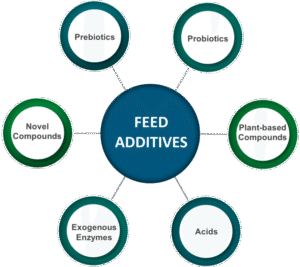1. Mycotoxins:
Thank you for reading. Don't forget to subscribe & share!
Mycotoxins are toxic secondary metabolites produced by molds (fungi) that grow on feed ingredients before or after harvest.
Common mycotoxins include aflatoxins, ochratoxins, fumonisins, deoxynivalenol (DON), zearalenone, and ergot alkaloids.
Mycotoxin contamination can occur in grains, cereals, oilseeds, and other feed ingredients during storage, transportation, or processing.
2. Pesticides and Herbicides:
Residues of pesticides, herbicides, and other agricultural chemicals used in crop production may contaminate feed ingredients.
Common pesticide residues include organophosphates, organochlorines, pyrethroids, and neonicotinoids, which can accumulate in feed crops and persist in feed processing.
3. Heavy Metals:
Heavy metals such as lead, cadmium, arsenic, mercury, and chromium may contaminate feed ingredients through soil, water, air, or industrial pollution.
Contamination of feed ingredients with heavy metals can occur during cultivation, processing, or storage, leading to potential toxicity and health risks for poultry.
4. Veterinary Drugs and Antibiotics:
Residues of veterinary drugs, antibiotics, and growth promoters used in animal production may enter the feed supply chain through medicated feed additives, feed premixes, or cross-contamination.
Overuse or misuse of veterinary drugs and antibiotics in feed can contribute to antibiotic resistance, residues in poultry products, and food safety concerns.
5. Industrial and Environmental Contaminants:
Industrial pollutants, environmental contaminants, and toxins from air or water pollution may contaminate feed ingredients, particularly those derived from plant-based or aquatic sources.
Examples include polychlorinated biphenyls (PCBs), dioxins, polycyclic aromatic hydrocarbons (PAHs), and persistent organic pollutants (POPs), which can bioaccumulate in feed ingredients and pose risks to animal and human health.
6. Plant Toxicants:
Certain plants and botanicals contain natural toxins, anti-nutritional factors, or alkaloids that can be harmful to poultry if ingested in large quantities.
Examples include toxic plants such as jimsonweed, nightshade, castor bean, and certain legumes that contain cyanogenic glycosides, lectins, or alkaloids with adverse effects on poultry health.
7. Processing Contaminants:
Contaminants generated during feed processing, such as heat-induced toxins, chemical residues, or microbial toxins, may pose risks to poultry health if not properly controlled.
Factors such as inadequate processing conditions, equipment hygiene, or cross-contamination can contribute to the presence of processing contaminants in feed.
8. Unintentional Additives:
Unintentional additives or contaminants may enter feed ingredients during production, transportation, storage, or handling processes.
Examples include mold inhibitors, insecticides, rodenticides, lubricants, or cleaning agents that may inadvertently contaminate feed ingredients and pose risks to poultry health.
Risk Management and Mitigation:
Preventive measures to manage and mitigate the risks associated with toxic substances in poultry feed include:
Implementing good agricultural practices (GAPs) and integrated pest management (IPM) strategies to minimize pesticide residues in feed crops.
Monitoring and testing feed ingredients for mycotoxins, heavy metals, pesticide residues, and other contaminants.
Using quality assurance programs, hazard analysis, and risk-based approaches to identify and address potential sources of contamination in feed production and processing.
Implementing proper storage, handling, and sanitation practices to prevent cross-contamination and minimize exposure to toxic substances in feed ingredients and finished feeds.
By implementing comprehensive risk management strategies and quality control measures, poultry producers, feed manufacturers, and regulatory authorities can effectively minimize the risks associated with toxic substances in poultry feed and ensure the production of safe, high-quality poultry products for human consumption.
Toxic substances in poultry feed can arise from various sources, including natural contaminants, agricultural chemicals, processing residues, and unintentional additives. These substances pose risks to poultry health, welfare, and food safety if present at elevated levels in feed ingredients or finished feeds. Here are some common toxic substances in poultry feed.









